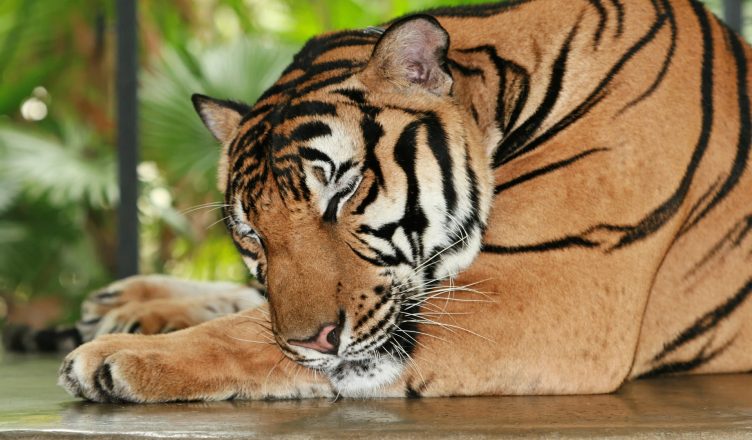The cat family is known as Felidae. Unlike our furry feline companions however, the bigger species of the Cat family are neither cuddly nor cute. Many are apex predators, sitting at the top of the food chain. All cats, from the house cat to the tiger, are carnivores. They have spikes on their tongues to aid in grooming themselves and tearing meat. Most cats can also retract their claws, except for the cheetah. Below are the 10 most powerful big cats that exist today.
10. Caracal
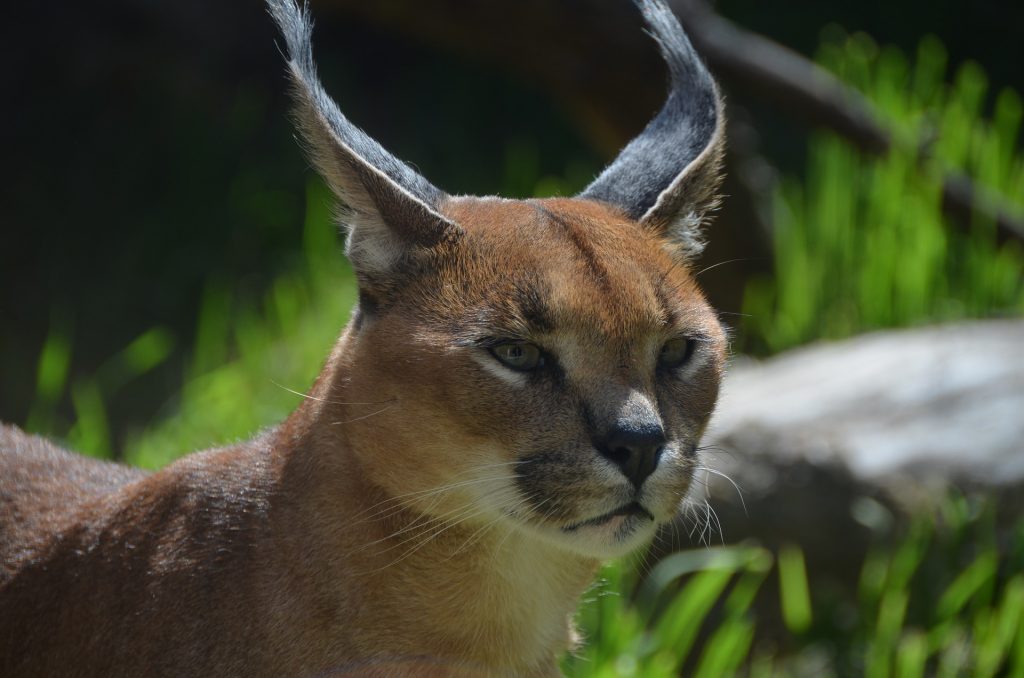
The caracal is a wild cat that live in the Africa, Middle East and Central Asia. They have a distinctive features that make them look different from other cats: hair that grow on their uniquely black ears like a lynx, long canine teeth and black marks that only exist near their eyes and forehead. The body fur of this cat does not have any marks and is usually a variant of brown, from pale to golden brown.
Caracals hunt at night. They usually eat small animals like rats, rabbits and birds. These felines are powerful jumpers which can easily leap to 4 meters to catch birds flying in the air. Caracals usually grow up to 50 centimeters high (20 inches) and weight about 19 kg (42 lbs.), and is considered a mid-sized feline. They usually live up to 16 years in the wild.
Caracals are usually solitary animals. Their cubs are adorable, leading to many people keeping them as exotic pets. However, these cats are wild animals at heart, and should not be kept as pets, as they can be unpredictable and dangerous.
9. Lynx
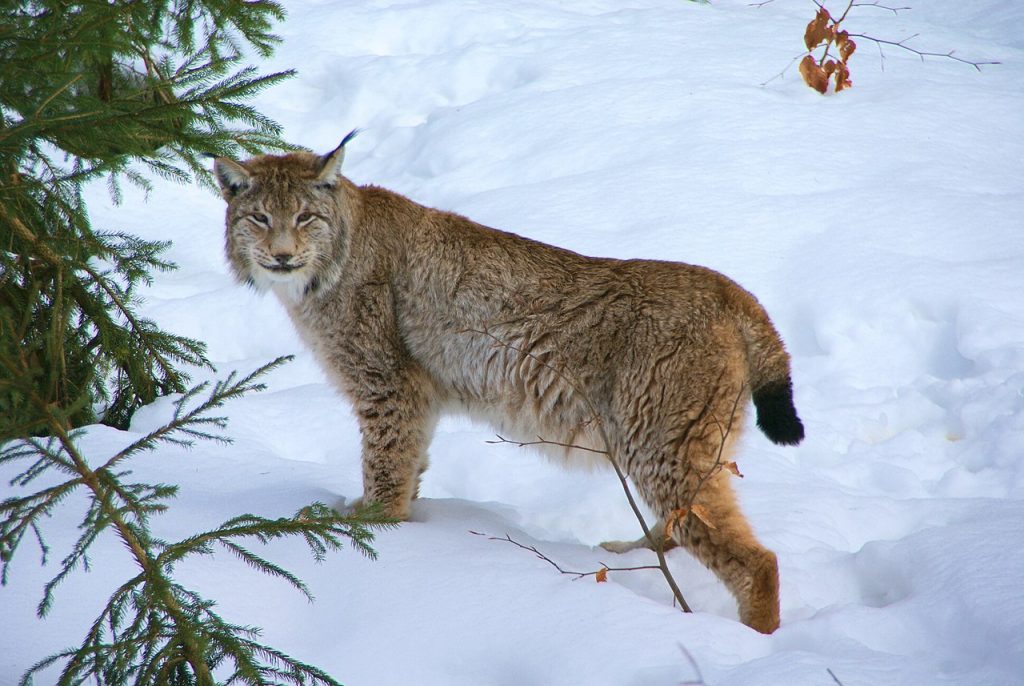
A lynx is a medium-sized member of the cat family. They are usually identified by the tuft of hair on each of their ears, and their unusually short tails. Unlike the caracal, lynx usually have spotted coats. There are four sub-species of lynx that exist, namely the Eurasian lynx, Canadian lynx, Iberian lynx and Bobcats.
Lynx usually hunt small mammals like hares, mouse and even small deer in the night. They exist in many parts of the world, ranging from Asia to Europe in the cold mountainous regions. Adult lynx can grow up to 130cm (51 inches) in body width, and up to 21 kg (46 lbs.). Depending on the species, these cats live up to 7 years for the bobcat and up to 15 years for the rest of the species in the wild.
These felines usually mate when seasons change between winter and spring. Baby lynxes are born in spring after a gestation period of about two months, usually in litters of one to four cubs. However, lynxes are mostly solitary, so cubs usually leave their mother’s side after a year of being born.
8. Snow Leopard
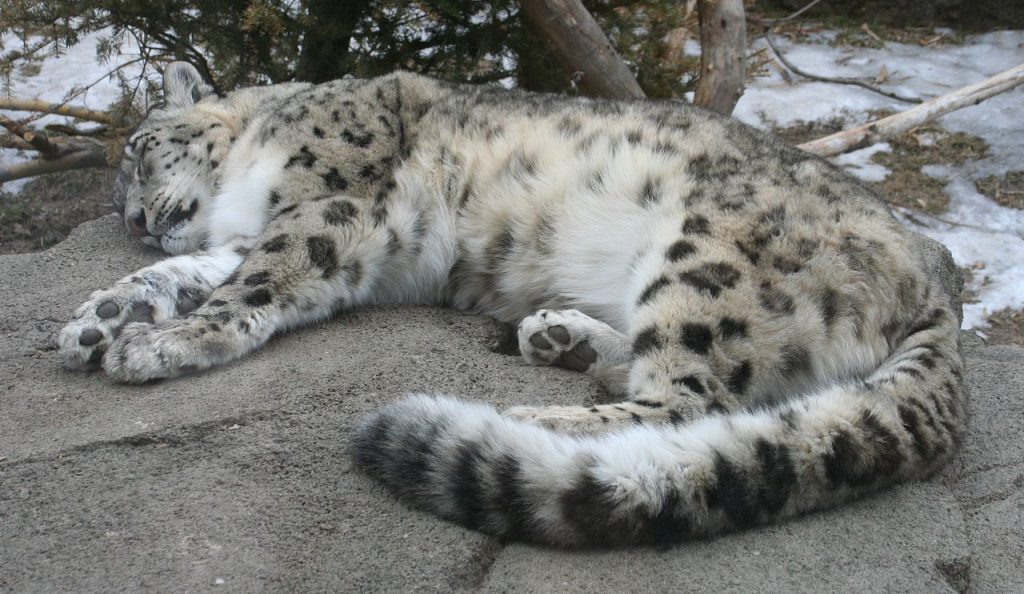
Snow leopard are big cats which lives only in parts of Asia, where there are snow and mountains. Despite its name, the snow leopard is a distinct species of big cats, and is a separate subspecies from the leopard. The snow leopard are considered to be monotypic, which means there are no subspecies of this feline.
To adapt to living in colder regions, these cats have thick white greyish fur to enable them to stalk their prey in the snow. They also have smaller ears and thicker tails compared to other big cats, which helps them to conserve body heat. These solitary felines hunt various species of sheep, goats and rodents which live in the mountain regions. Hunting time for these cats are usually dawn and dusk, and they usually sleep or relax for the rest of the day.
Although the oldest living snow leopard Shynghyz lived for 26 years in captivity, the average lifespan of a wild snow leopards is 15 to 18 years. These big kitties usually grow up to a maximum of 1.5 meters (59 inches) long and 55 kg (121 lbs.).
7. Clouded Leopard

The clouded leopard is a smaller-sized big cat native to the Himalayan mountain region and Southeast Asia. They are two subspecies of this predator, the mainland clouded leopard living in the Himalayas, while the Sunda clouded leopard mainly live in Borneo and Sumatra. Like the snow leopard, these cats are not actually leopards although they have the word leopard in their names.
These big-sized felines have distinct coat patterns of black patches on orange fur that run throughout their entire bodies, including their faces. They also have the largest canine teeth to body size ratio of any cat, which suggests that this cat species is the closest living relative of the sabre-tooth tiger. Male clouded leopards can grow up to 108cm (43 inches) and 23 kg (51 lbs.), while female clouded leopards are slightly smaller in size. Their average lifespan is about 12 to 15 years.
Clouded leopards feed on mammals such as deer and porcupines, rodents like squirrels and birds like pheasants. A lone hunter, they are exceptionally good at climbing trees, and usually rest among the trees after a good meal. Although they are mainly nocturnal, clouded leopards have also been known to hunt during twilight hours.
6. Cheetah
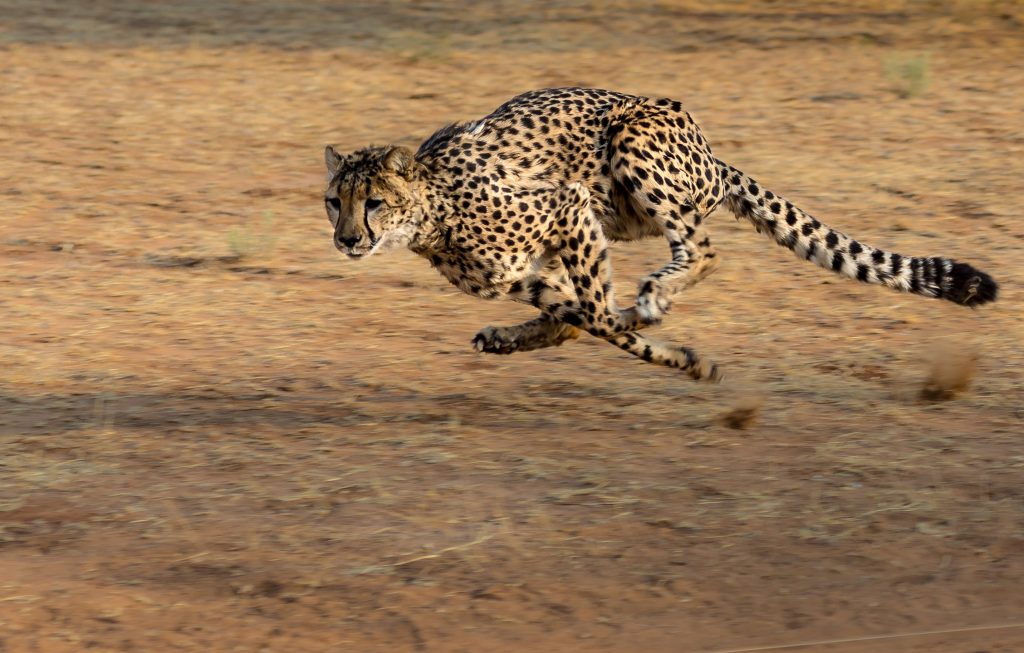
The cheetah is the fastest animal on land. With a slender body, coupled with a unique spine structure and long slim legs and tail, the cheetah is built for speed. Cheetahs are the only cat that are unable to fully retract their claws, a special adaptation to increase friction which allow them to run quickly. Their native habitat includes Africa and parts of Iran.
The recorded top speed of a cheetah is about 98km per hour (61mph), which they can achieve within 3 seconds of taking off. They cannot, however, sustain their sprint for long periods of time. Cheetahs are usually identified by the spot markings on their tawny brown fur, and black marks down their faces resembling tears. King cheetahs are cheetahs with recessive genes that cause them to get three black strips instead of dots on the back of their fur, and are not considered a sub-species of a cheetah.
Male cheetahs form groups to live and hunt together, while female cheetahs are usually lone hunters. Unlike many other cats, cheetahs are daytime hunters. These felines’ preferred food are antelopes and gazelles that graze in the area. They usually creep silently until they are in close range of their prey, surprise the target with their incredible speed, and kill the prey with a bite on the neck before it could run too far in a ‘shock and awe’ manner. Within a minute of the hunt, the cheetah would have succeeded or failed in taking down a meal.
5. Cougar

Cougars, also known as pumas and mountain lions, are big cats that live in the Americas continent. These cats are surprisingly related most closely to the common house cat, but are much larger. Cougars are the fourth largest cat, with males having body length of around 2.4 meters (7.9 feet) long and 68 kg (150 lbs.). Their coats’ color range from tawny to greyish brown, and do not have any stripes or spots.
These felines primary hunt elk and deer, although they will also eat other animals like zebras, raccoon and even otters if they can get their paws on them. Due to their solo hunting habits, after killing a larger animal that the cougar cannot finish in one sitting, it hides the corpse of the animal by covering them with plants and return to eat them over the next few days. The preferred hunting method of the cougar is the usual cat tactics: silently stalking and pouncing on their prey when the timing is right.
Cougars are listed as the animal with the most number of names in the Guinness book of world records. These incredible cats have been given over 40 names by humans.
4. Leopard
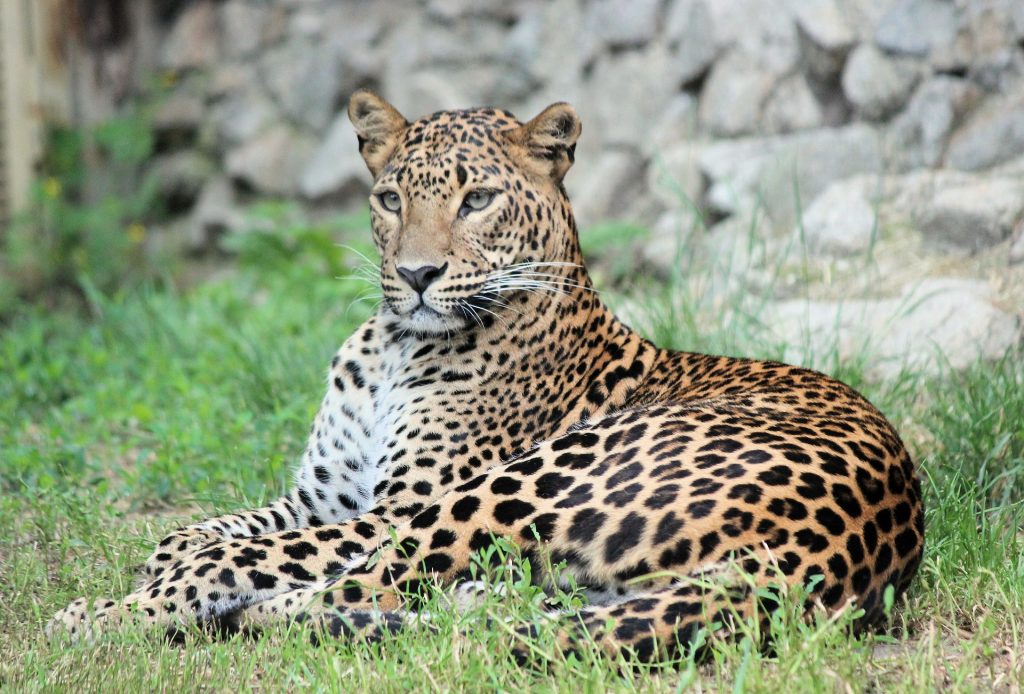
Leopards are spotted big cats that live in a huge variety of regions around the world, including Africa, Asia and Russia. There are eight main sub-species of leopards, with four of them being critically endangered. Leopards are the most closely related to lions in the feline family.
Leopards’ fur patterns are special. These patterns are known as rosettes, which are marks that look like roses. These marks cover the entire of the leopard’s body, including their face and tails. Their coats can range from pale brown to reddish-brown.
Female leopards are typically smaller than their male counterparts. The average size of a leopard is can vary between 0.9 to 1.9 meters (24 to 65 inches), depending on sub-species of the cat. Male leopards weight 37 to 90 kg (82 to 198 lbs), while females are lighter at 28 to 60 kg (61 to 132 pounds). The usual lifespan of a wild leopard is 12 to 15 years.
Leopards are nocturnal animals. Their days are usually spent sleeping on top of a tree. Being skilled climbers, leopard drag their meal up a tree to consume at its leisure after securing a kill. This prevents food from being stolen by a larger predator, such as a tiger.
3. Lion
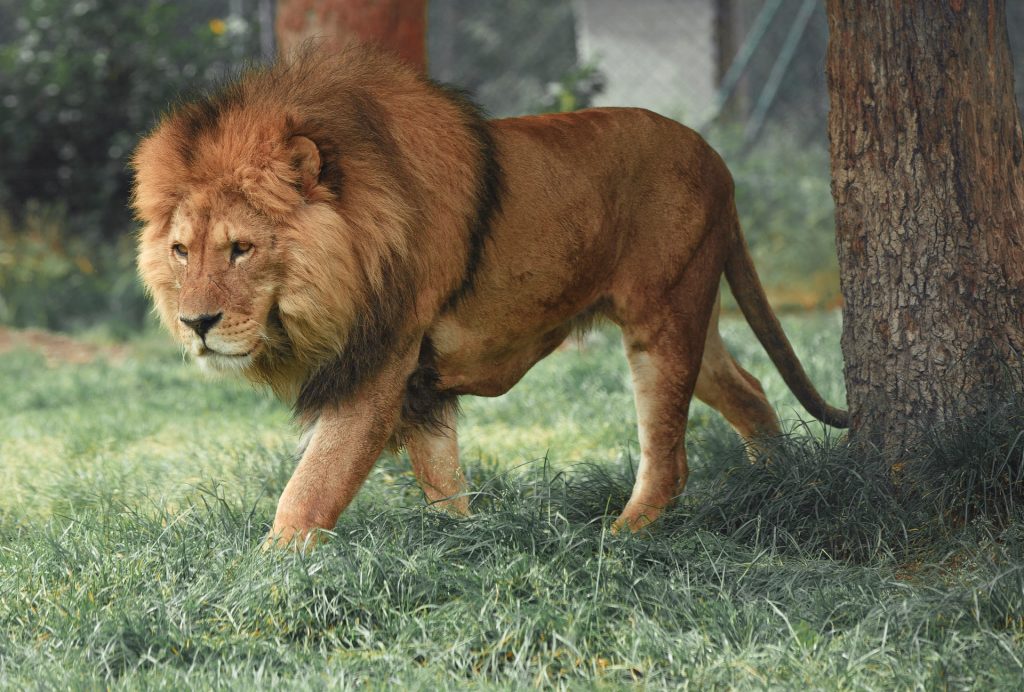
Known as the King of the Jungle, the lion is a symbol of pride and power. These royal beasts have a unique family structure. Unlike other big cats which usually live and hunt in solitary, lions form big groups for communal living known as prides. Female lions, or lionesses, make up the majority of the members of each pride, where they sleep, hunt and raise their cubs together. A male lion is the head of each pride.
Male lions are iconic animals with their manes that cover their heads and chests. Lions with darker males are considered healthier and and stronger due to having more testosterone, leading to more chances that their cubs surviving the harsh wildlands. Males can grow up to 2 meters (82 inches) in body length, and weight up to 225 kg (496 lbs). Lionesses are smaller, with a maximum body length of 1.8 meters (72 inches) and weighting at 140kg (310 lbs). They usually have light brown colored bodies.
Hunting as a pack allows the lion to take down bigger prey such as giraffes, wildebeests and buffalos. Lionesses usually take home the bacon in this aspect, with the male lion lazing waiting for his meal. The usual hunting methods are stalking until they are close enough to their potential meal, then honing in on the target. The prey running away from the main lioness are usually cornered by her pride mates from other directions. If the hunt is successful, the spoils are shared among the pride, with the male lion usually taking the biggest cuts of meat.
Despite being at the top of the food chain, lions sometimes do resort to behavior like stealing prey from cheetahs and leopards if they had not been successful in their hunting efforts.
2. Tiger
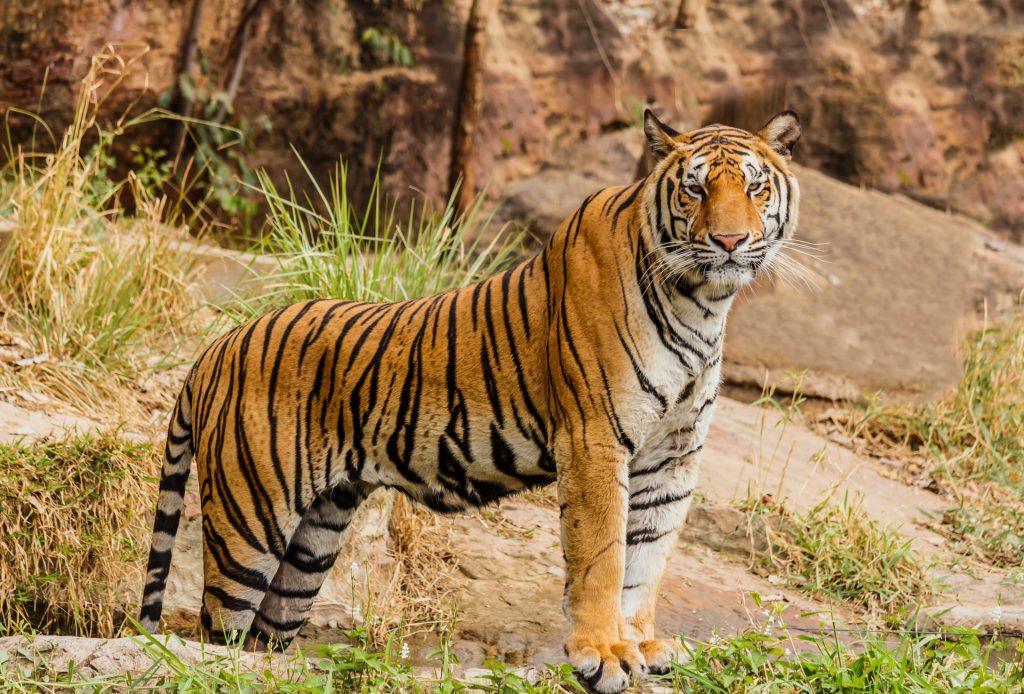
With their signature black stripes and orange body, the tiger is an instantly recognizable animal. These beautiful felines are the largest and heaviest big cat species in the world. They are the national animals of several countries, including the India, Malaysia and South Korea.
There are three subsets of fur color for these magnificent beasts. While most tigers have orange coats, there are rare tigers with coats that are white, golden, and even white and strip-less. The color of tigers’ coat are due to genetic mutation, and are mutations extremely rare. There are even records of a black tiger, which are actually white but with thick black blobs of stripes that make them look black.
Tigers have been known to grow up to 4 meters (13 feet) in length, and weight up to 300 kg (660 lbs.). Being solitary hunters, they have huge muscles to help them in bringing down prey. Female tigers are much smaller than their male counterparts, at a maximum of 2.75 meters (9 feet) and 167 kg (368 lbs.). Tigers usually go after bigger mammals such as wild boars and various species of deer. Tigers also enjoy swimming, and can even catch aquatic prey such as crocodiles.
There are nine known sub-species of tigers, but three of them have become extinct due to poaching and habitat destruction. The rest are considered critically endangered, with many sub-species having less than two thousand left in the wild.
1. Jaguar
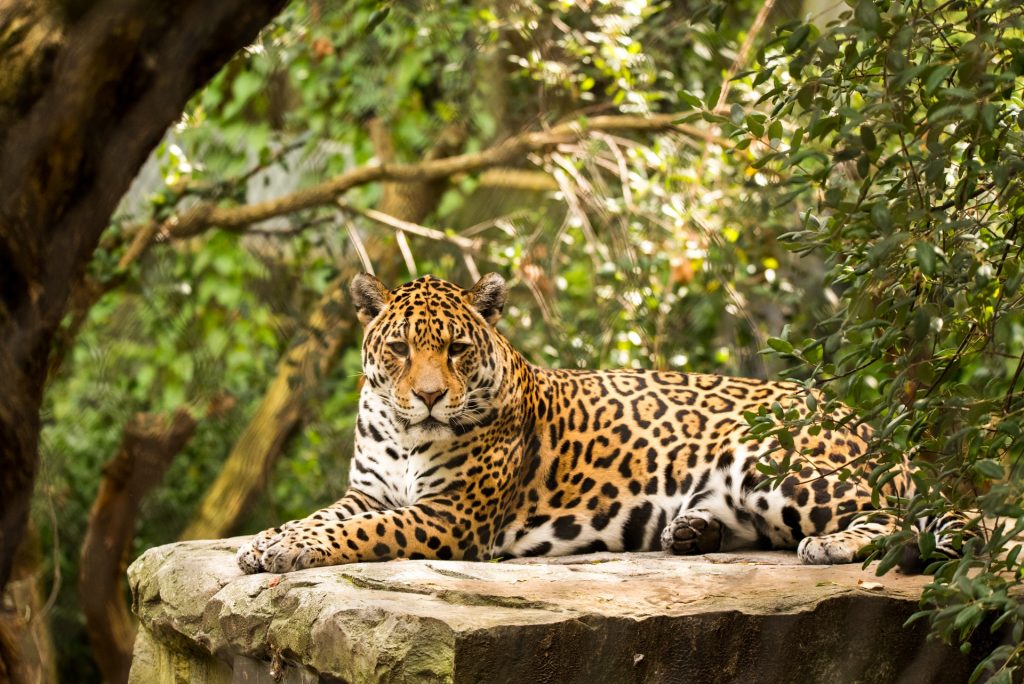
The jaguar is the third largest feline in the world. Like leopards, they have rosette spots all over their bodies, but with a dot in the middle of the spot. Originally hailing from the Americas continent, most of these animals have been unfortunately killed off. Most jaguars now reside in the Brazilian Amazon Basin.
Jaguars are mainly crepuscular hunters, which means that they hunt at dawn and dusk. Their preferred food are the capybara, a large rodent, and the giant anteater. They also prey on deer and boars. This stealthy feline stalks its target meal silently, and pounce on them when the target gets close enough. With the bite force of 1500 psi, the jaguar is the cat with the strongest bite within the feline family. In comparison, humans only have a bite force of about 160 psi.
Although jaguars usually kill by crushing their prey’s throat with their jaws, they sometimes hunt with a special method. They can choose to bite near the prey’s skull, where the bite can directly penetrate its brain, killing it instantly.
Jaguars can grow up to 1.85 meters (73 inches) and 158 kg (348 lbs.). They usually have a range of brown for coat colors, but some jaguars are black. These big cats can live 12 to 15 years in the wild, but illegal fur trade practices for its beautiful pelt have caused many of these animals to die before their time.
Bonus. Black Panther
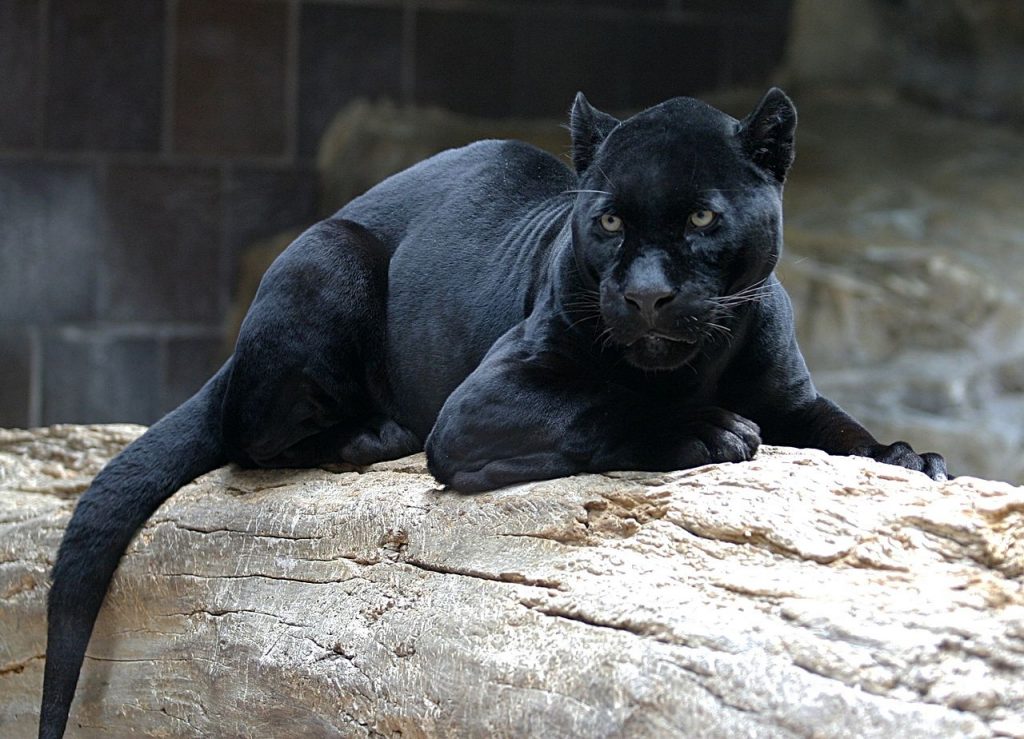
The Black Panther is not a species of the big cat. They mainly refer to jaguars and leopards who have black colored skins caused by a gene that produces more melanin than usual, causing their fur to become black. Although they still have rosette marks like regular jaguars and leopards, these markings are usually covered by the black fur of these animals.
Black panthers are rare. Although studies put black jaguars and leopards at about 11 percent of the population, it is uncommon to see one roaming in the wild. Black jaguars and leopards have no evolutionary advantages compared to the common colored ones. In fact, it may be detrimental to them as they as unable to flash the white side of their fur to communicate danger to other members of the same species.
Which of the above is your favorite big cat? Leave your comments below!

